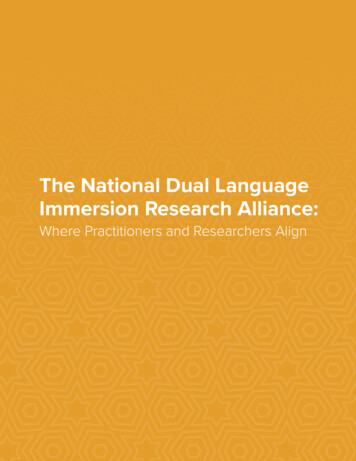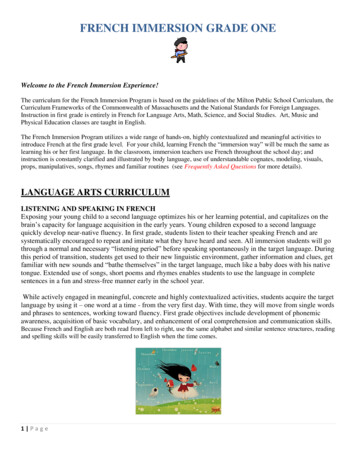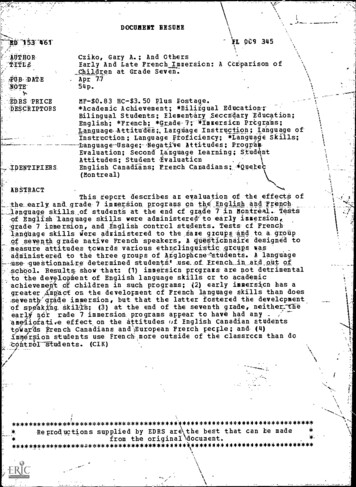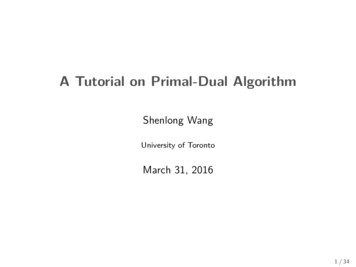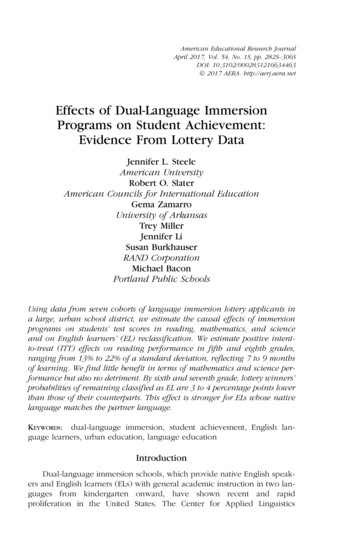
Transcription
American Educational Research JournalApril 2017, Vol. 54, No. 1S, pp. 282S–306SDOI: 10.3102/0002831216634463Ó 2017 AERA. http://aerj.aera.netEffects of Dual-Language ImmersionPrograms on Student Achievement:Evidence From Lottery DataJennifer L. SteeleAmerican UniversityRobert O. SlaterAmerican Councils for International EducationGema ZamarroUniversity of ArkansasTrey MillerJennifer LiSusan BurkhauserRAND CorporationMichael BaconPortland Public SchoolsUsing data from seven cohorts of language immersion lottery applicants ina large, urban school district, we estimate the causal effects of immersionprograms on students’ test scores in reading, mathematics, and scienceand on English learners’ (EL) reclassification. We estimate positive intentto-treat (ITT) effects on reading performance in fifth and eighth grades,ranging from 13% to 22% of a standard deviation, reflecting 7 to 9 monthsof learning. We find little benefit in terms of mathematics and science performance but also no detriment. By sixth and seventh grade, lottery winners’probabilities of remaining classified as EL are 3 to 4 percentage points lowerthan those of their counterparts. This effect is stronger for ELs whose nativelanguage matches the partner language.KEYWORDS: dual-language immersion, student achievement, English language learners, urban education, language educationIntroductionDual-language immersion schools, which provide native English speakers and English learners (ELs) with general academic instruction in two languages from kindergarten onward, have shown recent and rapidproliferation in the United States. The Center for Applied Linguistics
Dual-Language Immersion Programs and Student Achievement(2011a, 2011b) estimates that the number of immersion schools in the UnitedStates grew from 278 to 448 between 1999 and 2011, but more recent extrapolations place the latest number between 1,000 and 2,000 (Maxwell, 2012;Watanabe, 2011). For instance, through recent statewide efforts, Utah ishome to at least 118 language immersion schools and North Carolina to 94(North Carolina Department of Education, 2014; Utah State Office ofEducation, 2014). Meanwhile, the New York City Department of Educationmore than doubled the number of dual-language immersion programs itoffers, from about 82 to 192, between the 2012–2013 and 2015–2016 schoolyears (New York City Department of Education, 2015; Schneider, 2013). Thisproliferation is notable because in contrast to many other parts of the world,U.S. public schools have not traditionally exposed students to a second language in the early grades (Devlin, 2015). Even so, some evidence suggeststhat the popularity of dual-language immersion is growing internationallyas well as in the United States (Tedick, Christian, & Fortune, 2011).Domestically, this swift expansion of an approach that was recently considered boutique seems driven by several complementary forces: growth inthe share of U.S. school children who are ELs (U.S. Department of Education,2014), observational evidence that ELs in dual-language immersion programs outperform ELs in English-only or transitional bilingual programs(Collier & Thomas, 2004; Lindholm-Leary & Block, 2010; Umansky &Reardon, 2014; Valentino & Reardon, 2015), and demand from parents ofJENNIFER L. STEELE is an associate professor of education at American University, 4400Massachusetts Ave., NW, Washington, DC 20016-8030; e-mail: steele@american.edu.Her research addresses urban education policy, teacher quality, and transitions tocollege and career.ROBERT O. SLATER is a senior consultant for policy research at American Councils forInternational Education, where he studies programs aimed at fostering multilingualism and global citizenship.GEMA ZAMARRO is the 21st Century Endowed Chair in Teacher Quality at theDepartment of Education Reform at the University of Arkansas, where she studiesapplied econometrics in the areas of education, health, and labor.TREY MILLER is an economist at the RAND Corporation. His research focuses on developing, implementing, and evaluating policies and practices to improve studentaccess and success in higher education while also reducing the cost of higher education to students and taxpayers.JENNIFER LI is a management scientist and applied linguist at the RAND Corporation,where she conducts research on language education, language policy, organizationdevelopment, training, and workforce issues.SUSAN BURKHAUSER is an assistant policy analyst at the RAND Corporation, where shestudies school leadership and education policy.MICHAEL BACON is the assistant director of dual language for the Portland PublicSchools in Oregon, a role in which he develops and supports dual-language immersion programs across the district.283S
Steele et al.native English speakers who anticipate benefits of bilingualism within a globally competitive society (Maxwell, 2012). The expansion of these programsarrives at a time of rapid social and demographic change in the UnitedStates. Between 1980 and 2013, the share of young adults who spoke a language other than English at home more than doubled from 11% to 25% (U.S.Census Bureau, 2014). And recent projections by the Pew Research Centersuggest that by 2065, first-generation immigrants and their immediate offspring will together constitute 36% of the U.S. population, versus 26% today(Cohn, 2015).Though a number of studies have examined the performance of students in dual-language immersion versus monolingual education, mosthave been observational studies that, due to data constraints, could not fullyadjust for unobserved differences between immersion and non-immersionparticipants. Our study addresses this limitation by capitalizing on a lotterythat randomly assigns students—both native English speakers and ELs—tolanguage immersion in the Portland Public Schools (PPS) in Portland,Oregon. PPS is among the largest two public school districts in the PacificNorthwest, and our study represents the largest random-assignment studyof dual-language immersion that we are aware of; it also allows us to trackstudents across a diverse array of immersion schools for up to nine years. Wefind that students randomly assigned to immersion programs in kindergartenoutperform their counterparts in fifth grade reading by 13% of a standarddeviation and in eighth grade reading by more than a fifth of a standard deviation, and these estimates do not appear to vary by students’ native language. Conditional on their EL status at school entry, lottery winners are 3to 4 percentage points less likely to be classified as ELs in sixth and seventhgrade, and the estimates are larger for students whose native languagematches the partner language. The effects of lottery winning on mathematicsand science performance are indistinguishable from zero in most cases.In subsequent sections, we discuss prior studies of dual-languageimmersion programs and explain how immersion is implemented inPortland. We then describe our sample, methods, and results. We concludewith implications for policy in the globalized 21st-century economy.BackgroundSubstantial research from cognitive psychology points to the cognitivebenefits of bilingualism, such as improved working memory and attentioncontrol (Bialystok & Craik, 2010; Bialystok, Craik, & Luk, 2008). These functions appear to play a key role in solving mathematics problems and comprehending written material (Alloway, 2007; Gathercole, Alloway, Willis, &Adams, 2006). Immersion education is a comprehensive instructionalapproach that may yield direct academic benefits—proficiency in multiplelanguages—while also benefitting cognition and generalized academic284S
Dual-Language Immersion Programs and Student Achievementperformance (Esposito & Baker-Ward, 2013). Researchers have reached different conclusions about the extent to which linguistic similarity mediatesa bilingual advantage, with some evidence suggesting that orthographicallysimilar languages confer greater benefits in executive control (Coderre & vanHeuven, 2014) and other evidence suggesting little difference (Paap,Darrow, Dalibar, & Johnson, 2014).Research on academic impacts of dual-language immersion programscan be divided into studies that have focused primarily on native speakersof the cultural majority language (e.g., English in the United States) andthose that have focused mainly on students who first arrive at school withoutfluency in the majority language (e.g., ELs in the U.S. context). The formercategory includes a few studies that are quite rigorous but small in scale,while the latter category features studies that, due to data availability, havebeen more vulnerable to selection bias. In the first category, one pioneeringstudy of a French immersion program in Canada found that native Englishspeaking students randomized to French immersion in kindergarten laggedtheir counterparts on some measures of English language arts until fifthgrade, at which point they matched or outperformed their peers in both language arts and mathematics (Lambert, Tucker, & d’Anglejan, 1973). Thoughthe study was rigorously designed, it was conducted on a small scale, withonly 48 randomized participants observed through Grade 5. In the UnitedStates, one randomized study of dual-language immersion in a preschoolfound mostly positive benefits on students’ Spanish reading skills amongnative Spanish and native English speakers and no clear detriment or benefitto reading skills in English, but the study included only 150 students and wasable to track students for only one year (Barnett, Yarosz, Thomas, Jung, &Blanco, 2007). In a study of 124 mostly native English speakers ina Mandarin immersion program, Padilla, Fan, Xu, and Silva (2013) demonstrated that immersion students outperformed same-school peers on anEnglish language arts examination in Grades 3 through 5, but though theimmersion group was admitted by a randomized lottery, the same-schoolcomparison group was not necessarily randomly assigned. Because all threestudies focused on single schools, the extent to which their findings wouldgeneralize to larger-scale programs is also unclear. Other studies that haveshown benefits of immersion programs for native English speakers inCanadian or U.S. contexts have generally not employed extensive controlsfor possible selection bias (Barik & Swain, 1978; Caldas & Boudreaux,1999; Marian, Shook, & Schroeder, 2013; Turnbull, Hart, & Lapkin, 2003).Meanwhile, most studies of dual-language immersion in the UnitedStates have focused on the outcomes for ELs whose native language matchesthe partner (i.e., non-English) language. Note that for ELs, dual-languageimmersion serves as a possible alternative to monolingual English instructionand to bilingual education programs in which students receive core instruction in their native language until they are able to transition to monolingual285S
Steele et al.English classes in early or later elementary school. (Early-transition programsare sometimes called transitional bilingual, and later-exit programs are sometimes called developmental bilingual programs; Francis, Lesaux, & August,2006; Valentino & Reardon, 2015). A key distinction of dual-language immersion programs is that they typically include native English speakers alongside ELs and may therefore segregate ELs less than transitional ordevelopmental bilingual programs. Some dual-language immersion programs—called two-way programs—are explicitly designed to serve nativespeakers of both languages, whereas one-way programs primarily serve students who are new to the partner language (Collier & Thomas, 2004; Fortune& Tedick, 2008; Tedick et al., 2011).It is plausible that dual dual-language programs may exert differentlearning effects for ELs than for native English speakers. Immersing ELs intheir native language for at least part of the school day allows them toreceive a substantial share of core academic content instruction in a languagethey understand, share a classroom with native English speakers, and beginschool with a baseline advantage over their monolingual English-speakingpeers in terms of knowledge of the partner language. The notion that ELsbenefit from school-based instruction in their first language is bolstered byseveral meta-analyses that have focused not on dual-language immersionprograms per se but on the effects of transitional bilingual education programs relative to English-only programs for ELs (Francis et al., 2006;Greene, 1997; Slavin & Cheung, 2005).Though Valdés (1997) cautions that integrating native speakers ofEnglish with native speakers of the partner language may reinforce existingpatterns of social inequality, studies that have specifically compared ELsattending dual-language immersion to those attending monolingualEnglish or transitional bilingual programs have generally found outperformance among students in dual-language immersion (Collier & Thomas, 2004;Lindholm-Leary & Block, 2010; Marian et al., 2013; Thomas & Collier, 2015).Historically, these studies have not included many adjustments for baselinebetween-group differences, rendering them vulnerable to selection bias, butmore recently, two studies have used large-scale administrative data with statistical adjustments to mitigate at least observable sources of bias.Specifically, Umansky and Reardon (2014) employed hazard analysis withextensive statistical controls, finding that Latino ELs placed in Spanishimmersion classrooms were reclassified from English learner to Englishproficient status more slowly in elementary school but at higher rates byhigh school.1 Also, Valentino and Reardon (2015) compared the academicperformance of ELs placed in monolingual English instruction, transitionalbilingual education, developmental bilingual education, and dual-languageimmersion programs. They found that the English language arts performance of EL students in all three of the bilingual programs, including286S
Dual-Language Immersion Programs and Student Achievementdual-language immersion, grew as fast as or faster than their peers in monolingual English programs.Taken together, the existing research on dual-language immersion education for ELs and native English speakers suggests that families who areable to enroll their children in dual-language immersion programs canexpect to see equivalent performance or even outperformance in Englishlanguage arts by elementary school, but the extent to which selection is driving these estimates is less clear.The present study contributes to this body of research in several ways:First, it is one of few studies to examine the general academic effects ofimmersion program on native English speakers as well as ELs in theUnited States and to do so longitudinally between kindergarten and (forthe oldest two cohorts) eighth grade. Second, it examines effects at scalein a large urban district, focusing on 12 schools and four partner languages.Finally, it leverages data from a district-wide lottery system in order to estimate causal effects over time, integrating test scores from a state data systemto track students who leave the district but remain in the state. As such, itrepresents the largest random-assignment study of dual-language immersionprograms we are aware of, and it is able to estimate causal effects over timefor native English speakers as well as for native speakers of other languages.Our analysis responds to three research questions:Research Question 1: What is the causal effect of random assignment to a duallanguage immersion program on student achievement in mathematics,English language arts, and science and (for students who began as ELs in kindergarten) on students’ subsequent classification as ELs?Research Question 2: To what extent do immersion program effects differ for oneway versus two-way immersion programs and for programs in Spanish versusMandarin, Japanese, and Russian?Research Question 3: To what extent do immersion program effects depend onwhether a student’s first language is English and on whether the student’s firstlanguage matches the partner language?Our lottery-based design allows us to estimate causal effects based on students’ random assignment to immersion programs, but because access tothese programs may influence not only students’ classroom language exposure but also the teachers and peers with whom students engage, we cannotdefinitively attribute all program effects strictly to the language of instruction.However, we do report on exploratory mediation analyses in the appendixin the online journal.Intervention and SettingPortland Public Schools began implementing dual-language immersionprograms in 1986. During the 2012–2013 academic year when our study287S
Steele et al.commenced, it maintained programs in 11 elementary schools, 4 middleschools, and 5 high schools, with instruction in Spanish, Mandarin,Japanese, and Russian. In that year, about 8% of Portland’s students, or3,860 individuals, were enrolled in immersion. Key characteristics of theseprograms are summarized in Table 1, including their instructional modelsand student composition.During the school years in our analysis, the Russian program and all butone of the Spanish programs followed a two-way model in which about halfof the students were native speakers of the partner language—Spanish orRussian—and the other half were native speakers of English or another language. The district’s other immersion programs (Japanese, Mandarin, andone Spanish program) offered a one-way model, in which most studentswere native English speakers.Two-Way ProgramsAs noted in Table 1, the two-way programs in Portland follow a 90/10instructional model, meaning that in kindergarten, 90% of the school dayis conducted in the partner language and 10% in English. The partnerlanguage proportion then declines by 10 percentage points per grade. Ingrades K–3, students receive 75% to 100% of mathematics instruction, 56%to 100% of language arts instruction, and about 100% of science and socialstudies instruction in the partner language. In Grades 4 and 5, they receiveabout 25% of mathematics, 58% of language arts, and 100% of science andsocial studies instruction in the partner language. Middle school studentstake one language arts class in English, one language arts class in the partnerlanguage, and one social studies class in the partner language; the rest oftheir classes are conducted in English. High school immersion students typically take only one class per day—an advanced language class—in the partner language.One-Way ProgramsIn Portland’s one-way programs, instruction of core content (mathematics, language arts, science, and social studies) follows a 50/50 instructionalmodel in each elementary grade. Each day, half of the instruction in eachcore subject occurs in the partner language, and half occurs in English(see Table 1). In middle and high school, however, one-way and two-wayprograms operate similarly, with middle school immersion students takingabout two classes per day in the partner language and high school studentstaking about one per day.Instructional Practice and Partner-Language LearningImmersion and non-immersion students in the district are held to thesame academic content standards, and the district develops or purchases288S
289S’ Half English’ Half partnerlanguageMostly English(no nativespeaker setaside slots)50/50 one-wayNative Languageof Students90/10 two-wayProgram Type50 in Grades K–52 periods inmiddle school1 period inhigh school90 in Grade K80 in Grade 170 in Grade 260 in Grade 350 in Grades 4–52 periods inmiddle school1–2 periods inhigh school% of Instruction inPartner ages1 elementary1 middle school1 high school1 elementary1 middle school1 high school1 elementary1 middle school1 high school7 elementary3 middle school2 high school1 elementarySchools (Elementary,Middle, High)Table 1Summary of Portland Public Schools Immersion Programs in the )Students in 2012–2013(and % of total)
Steele et al.partner-language curricula to make this possible. Still, it is possible thatinstructional practices would differ between immersion and non-immersionclassrooms. In the spring of 2014, our research team conducted observationsof 119 forty-five–minute instructional sessions, noting that time allocated tothe partner language in each subject and grade (focusing on Grades 1, 3, and5) was reasonably consistent with the aforementioned district guidelines forthe 90/10 and 50/50 models. In our observations of 46 immersion and 33English-only classrooms in the 2012–2013 academic year, we recorded similar distributions of on-task student behavior and instructional strategiesacross languages (including monolingual English classes), though all observations were conducted in schools that had immersion programs. In terms ofproficiency in the partner language, district-administered eighth-grade testsof immersion students using the Standards-Based Measurement ofProficiency (STAMP-4S) (Avant Assessment, 2015) suggest that immersionstudents in Spanish and Chinese reach intermediate-mid-level proficiency(5 to 6 on 9-point scales) by Grade 8; students in Japanese reach intermediate-low-level proficiency (4 to 5 on 9-point scales).Entry to Immersion in PortlandStudents receive admission to immersion programs in Portland througha lottery process administered by the school district. In the spring prior totheir child’s pre–k or kindergarten year, families may apply for up to threeschool programs of their choice (including immersion and a few other program types), in order of preference. The number of lottery slots available ina given program and year is established by the school principal, and someschools establish multiple preference categories, such as slots for nativespeakers of the partner language, students who live in the school’s catchment neighborhood, and students living in other neighborhoods. Studentsreceive a random lottery number for each preference choice, but in practice,all immersion slots are filled in the first lottery round.Within each round, slots in a given school and preference category arefilled first by students who have siblings at the school, then by other applicants who reside with the school district, and then by applicants from outside the district. Consequently, for any given school and preferencecategory, randomization will occur for only one of the three subcategories—co-enrolled siblings, no co-enrolled siblings, or out-of-district. We consider a lottery to be binding only if there are winners and losers withina given category and subcategory in a given year. In other words, only a subset of lottery applicants is truly randomized, and we limit our lottery-basedanalysis to this subset. Students who do not win an immersion slot areassigned to the regular instructional program in their default neighborhoodschools.290S
Dual-Language Immersion Programs and Student AchievementData and SampleThe study focuses on the seven cohorts of students who applied to apre–k or kindergarten immersion slot in Portland for the fall terms of 2004through 2010.2 Outcome data are measured through the 2013–2014 academicyear, so the oldest cohort can be observed through ninth grade and the youngest through third grade. The lottery applicant sample includes 3,457 students,and we also have data on 24,841 other students who enrolled in the district aspre-kindergarteners or kindergarteners during the years in question.The CONSORT diagram (Schultz, Altman, & Moher, 2010) shown inFigure 1 describes the randomization process. Of the 3,457 students whoapplied to Portland immersion lotteries during the study years, 1,946(56.3%) were truly randomized within a binding lottery category and subcategory. Of those truly randomized, 44.4% won immersion slots (the treatmentgroup), and 1,082 (55.6%) did not (the control group). Working with theOregon Department of Education (ODE), we were able to obtain outcomedata (reading, mathematics, or science scores or English language learning status) for 1,625 randomized students, meaning that overall sample attrition is16.5%.3 Attrition is 13.0% for the treatment sample and 19.3% for the controlsample, yielding differential attrition of 6.3 percentage points.4 This combination of overall and differential attrition rates lies very near the conservativethreshold for meeting What Works Clearinghouse (2014) evidence standards,and it falls easily within the liberal threshold. To provide further assurance ofbalance—and to improve the precision of our estimates—our models adjustfor observed baseline characteristics as well as lottery strata fixed effects.Intent-to-treat effects, which are the estimated effects of winning the lottery, may of course understate the effect of immersion program enrollment.In the analytic sample, compliance with assigned status is 77% for the treatment group and 73% for the control group, where compliance for winners isdefined as kindergarten enrollment in a Portland immersion program, andcompliance for those not placed is defined as not enrolling in a Portlandimmersion program in kindergarten. We use instrumental variables (IV) analyses (Angrist & Pischke, 2008) to recover the effect for those who complywith their random-assignment status.Sample CharacteristicsThe left side of Table 2 presents descriptive statistics for the randomized(binding) analytic sample, and the right side presents comparable information for the full sample of pre–k and kindergarten entrants to Portland.For binding lottery applicants, the intent-to-treat condition is defined as winning or not winning an immersion slot; for all Portland kindergartenentrants, the treatment is enrollment in immersion in kindergarten, and thecomparison condition is not enrolling in immersion in kindergarten. Table2 also presents the difference between groups for each variable and p values291S
Steele et al.Figure 1. CONSORT sample attrition diagram.for t tests of the differences. Because t tests are affected by sample size, onemight be more concerned with the magnitude of the difference in terms ofpooled standard deviation units (What Works Clearinghouse, 2014), whichwe report at left for the full sample. For the randomized group, the p valuesare adjusted for lottery strata fixed effects and thus refer to within-strata differences. The bottom panel of Table 2 indicates the number of students inthe analytic sample at each grade; it becomes smaller over time primarilybecause cohorts are observed for different lengths of time. Because theninth-grade sample includes only one cohort, ninth-grade estimates areespecially noisy and are not reported in our analysis.Outcome MeasuresStudent achievement in reading, mathematics, and science is measuredby performance on the state-mandated accountability test, the OregonAssessment of Knowledge and Skills (OAKS). Mathematics and reading testsare administered annually in Grades 3 through 8 and once in high school;science is tested in Grades 5 and 8. The tests are administered solely inEnglish. We standardize scores to have mean zero and standard deviationone within grade level, subject, and school year. We also examine a student’sstatus as an EL in each academic year after kindergarten, adjusting for his or292S
sion anguageImmersion ll Kindergarten Entrants to Portland Public 690.3670.3780.149PooledSDNote. For the binding lottery subgroup, p values reflect balance within randomization strata. Ns by grade in the analytic sample reflect not only attritionbut the fact that cohorts are observed for different lengths of time.NProportionFemaleAsianBlackHispanicWhiteOther raceSubsidized meal-eligibleSpecial needs in kindergartenGifted in kindergartenEnglish learner in kindergartenFirst language not EnglishFirst language partnerNs by gradeKindergartenGrade 1Grade 2Grade 3Grade 4Grade 5Grade 6Grade 7Grade 8Grade 9VariableBinding Lottery Applicants OnlyTable 2Descriptive Statistics for Applicants to Binding Lottery Strata Who Are Observed in the Analysis and for All Kindergarten Entrants to theDistrict in the Same Cohort (Proportions Are Within Column)
Steele et al.her status at kindergarten entry. Students in Portland may be classified as ELeach year based on their status the prior year and their overall performanceon the English Language Proficiency Assessment (ELPA). ELPA tests are typically administered between January and March. We code a student as beingan EL until the first full school year in which he or she no longer qualifies forservices based on ELPA scores.5Analytic StrategyFull-Sample Analysis: Generalized Least SquaresTo gauge the relationship between immersion and performance in thefull sample of kindergarten entrants to Portland, even for those not randomized, we first undertake a covariate-adjustment approach in
Massachusetts Ave., NW, Washington, DC 20016-8030; e-mail: steele@american.edu. Her research addresses urban education policy, teacher quality, and transitions to . one randomized study of dual-language immersion in a preschool . immersion group was admitted by a randomized lottery, the same-school comparison group was not necessarily .


